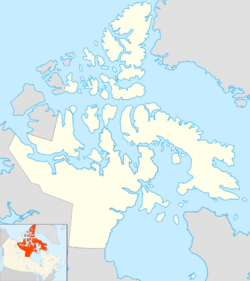Cocked Hat Island facts for kids
| Geography | |
|---|---|
| Location | Northern Canada |
| Coordinates | 78°47′N 074°34′W / 78.783°N 74.567°W |
| Archipelago | Queen Elizabeth Islands Canadian Arctic Archipelago |
| Administration | |
|
Canada
|
|
| Territory | Nunavut |
| Demographics | |
| Population | Uninhabited |
Cocked Hat Island is a small island located in the far north of Canada. It is found off the eastern coast of Ellesmere Island. This island is part of the Nunavut territory, specifically within the Qikiqtaaluk Region.
Cocked Hat Island is also part of a larger group of islands called the Canadian Arctic Archipelago. It belongs to the Queen Elizabeth Islands, which are known for their cold, icy environments. The island gets its name because it is shaped a bit like a cocked hat. It is located about 6 kilometers (about 3.7 miles) north-northwest of Pim Island.
Contents
Exploring Cocked Hat Island
This section tells you more about the island's location and its unique shape.
Where is Cocked Hat Island located?
Cocked Hat Island is in the northern part of Canada. It is very close to the Arctic Circle. This means it has a very cold climate for most of the year. The island is surrounded by the waters of the Arctic Ocean.
What makes the island special?
The most interesting thing about Cocked Hat Island is its shape. It looks like a "cocked hat," which is a type of hat that was popular a long time ago. This unique shape helps people remember its name. The island is also uninhabited, meaning no people live there permanently.
History of Exploration
This section explores the past attempts to reach Cocked Hat Island.
Early Attempts to Land on the Island
In 1883, a group of explorers led by Adolphus Greely tried to reach Cocked Hat Island. They were part of the Lady Franklin Bay Expedition. The team had spent two months traveling south from their base at Fort Conger.
Challenges Faced by Explorers
The journey was very difficult because of the thick ice and strong winds. These harsh conditions made it impossible for Greely's expedition to land on Cocked Hat Island. Instead, they were pushed further south. They ended up about 6 kilometers (3.7 miles) away at Cape Sabine on nearby Pim Island. This shows how challenging exploration in the Arctic can be.



